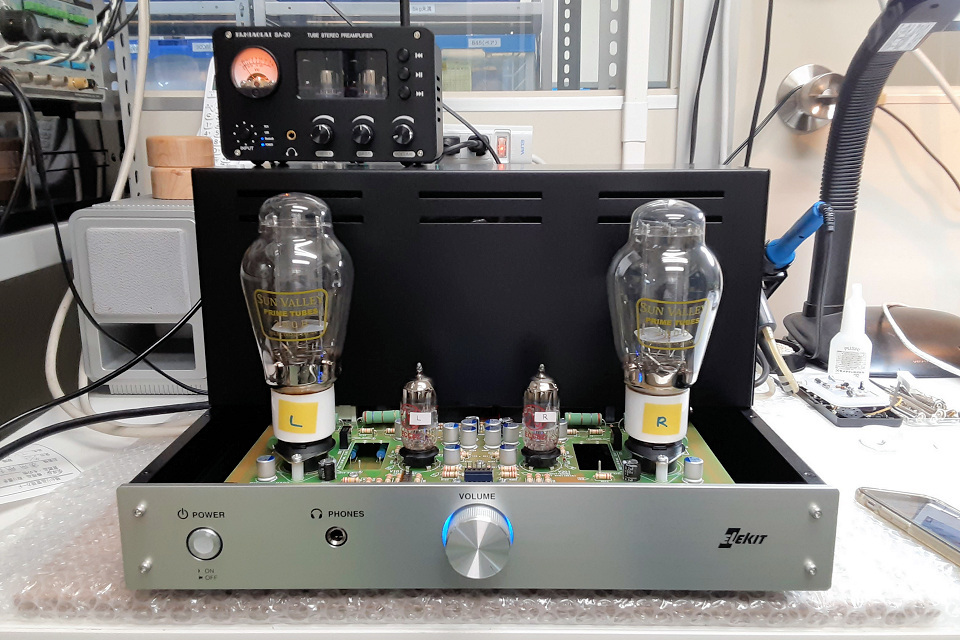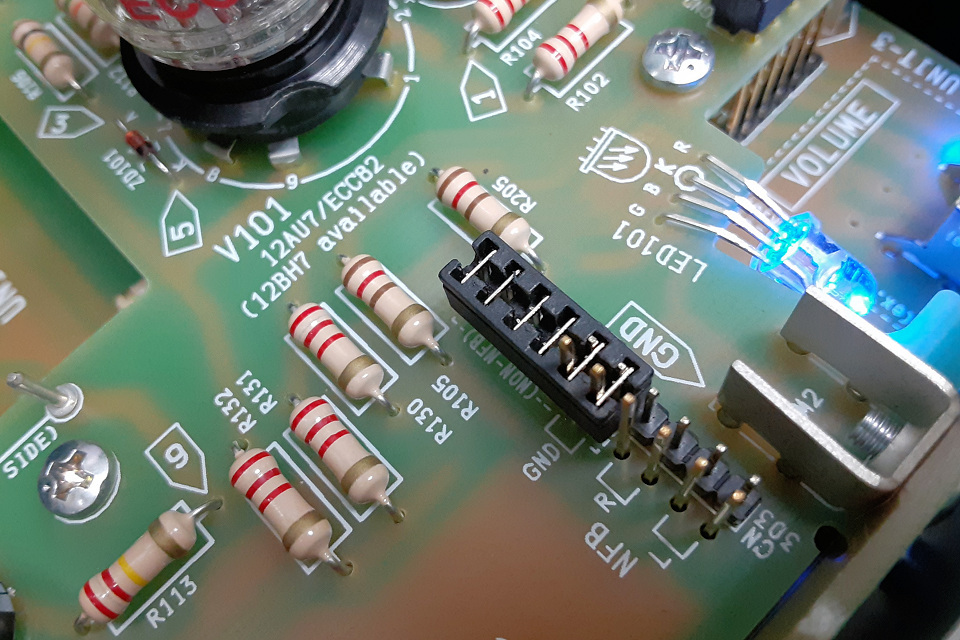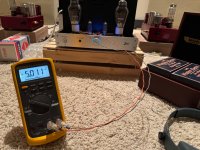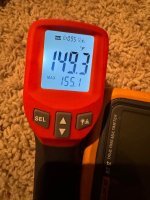this message was wriiten few days ago.. but i forgot to post
As long as your test points are with in spec. It is ok
Are you using preamp with TU-8900?
Do not turn TU-8900’sto the max to use with your preamp
As long as your test points are with in spec. It is ok
Are you using preamp with TU-8900?
Do not turn TU-8900’sto the max to use with your preamp
Filament Voltage
Being anal, I was concerned about our high mains voltage (124V) and how it might affect the filament voltage on pricey 300B/2A3 tubes.
Proper filament voltage is critical to tube life.
Of course, the 8900 has a sophisticated power supply, but I still had to know for sure. I did mention that I’m anal.
The common standard for filament voltage is +/-5%. This was OK when tubes were plentiful and cheap, but far from ideal. EML has an excellent article about this on their website. if you look at the graphs there, you can see that the best longevity from your expensive tubes is attained at -0 to +1% filament voltage.
I measured the 8900s filament voltage (directly at the tube pins) while plugged directly into the wall at 124 V, and then again plugged into bucking transformer at 117 V. The 8900 didn’t flinch at the voltage changes, maintaining the filament voltage rock steady at exactly 5.01 V! Perfect!
(I will note that, based on my extremely crude and likely inaccurate measurements, the temperature on the power boards increased 2.5°C at the higher wall voltage, but was still well below any reasonable limits for electronic components at 68°C. Photo is in Fahrenheit)
I can now relax and enjoy the music while running my expensive western electrics, and soon to be acquired EML tubes…Well done Elekit!!!
Being anal, I was concerned about our high mains voltage (124V) and how it might affect the filament voltage on pricey 300B/2A3 tubes.
Proper filament voltage is critical to tube life.
Of course, the 8900 has a sophisticated power supply, but I still had to know for sure. I did mention that I’m anal.
The common standard for filament voltage is +/-5%. This was OK when tubes were plentiful and cheap, but far from ideal. EML has an excellent article about this on their website. if you look at the graphs there, you can see that the best longevity from your expensive tubes is attained at -0 to +1% filament voltage.
I measured the 8900s filament voltage (directly at the tube pins) while plugged directly into the wall at 124 V, and then again plugged into bucking transformer at 117 V. The 8900 didn’t flinch at the voltage changes, maintaining the filament voltage rock steady at exactly 5.01 V! Perfect!
(I will note that, based on my extremely crude and likely inaccurate measurements, the temperature on the power boards increased 2.5°C at the higher wall voltage, but was still well below any reasonable limits for electronic components at 68°C. Photo is in Fahrenheit)
I can now relax and enjoy the music while running my expensive western electrics, and soon to be acquired EML tubes…Well done Elekit!!!
Attachments
Last edited:
love the massive base you have the Elekit sitting on 😉
Ha! I keep meaning to get a proper stand. Somehow I get caught up in other frivolous projects, such as measuring filament voltage! You should see the rest of the room! A mess!
Last edited:
Did you check the 12au7/12bh7 filament voltage
No, a little more difficult to access the smaller pins in this manner without accidentally shorting something out . But it’s on the list. At least they’re not quite as expensive as the power tubes.
This was translated from Mr Ohashi's Japanses blog (Google Translation).
April 29, 2025
Today's blog is posted at an unusual time. I've never written at this time, even when I was writing the old blog. I have an important announcement to make tomorrow, so I came to work earlier than usual and worked hard on aging and measuring the items to be delivered after the Golden Week holidays.

First up is the TU-8900 / Bamboo set. The Bamboo set features the Prime 300B ver.4, aiming for a powerful and full-bodied sound.

I tried to bring out the power of the sound by using non-feedback for the NFB. I will repost my previous post about the merits and demerits of the NFB, so please read it again. Personally, I prefer a "lightly cosmetic" specification with a very light NFB, but from the manufacturer's point of view, it is actually more convenient (easier) in many ways to apply a deeper NF.
First of all, no feedback means that there is no feedback in the amplification system, so the individual differences in vacuum tubes are clearly visible. For example, even if the left and right gains are the same in an amplifier with 6dB of NFB, when you use it with another no-feedback amplifier, the left and right gain difference is more than 1dB... This is a common occurrence. In other words, the selection of vacuum tubes becomes much more strict for no-feedback amplifiers, which means increased labor costs and reduced vacuum tube yields for manufacturers.
Another big benefit is that it improves the apparent measurement results. As you can see from the graph quoted in the previous entry above, applying NFB flattens the frequency response, making the nominal frequency response look better. NFB also reduces the amplifier gain, which reduces the apparent residual noise... it's all good for the seller.
However, as I have said before, characteristics and listening sensation do not always match, and especially with directly heated triodes and high NFB amplifiers, the sound tends to lose freshness and lack color and speed. If you have an amplifier that allows you to select whether to have feedback or not, such as our JB-320LM or this TU-8900, please compare them. Depending on your equipment environment and the genre of music you listen to, there may be cases where no feedback is clearly a better fit.
Thanks very much for reposting this Victor. I really enjoy reading Mr. Ohashi's thoughts.
In my own case, I've found the magic combination for me with the TU-8900 is Western Electric new production 300Bs, the Sylvania NOS 12BH7 drivers and no feedback. This tickles my emotional "funny bone" whether I am driving Avantgarde Duo SD G3 horn speakers or Sony MDR-Z1R headphones.
What is very cool with the TU-8900 though is that it is several amps in one, giving the user options for feedback or no feedback, 300B or 2A3, and choice of driver tubes, whatever suits one's particular mood, sonic pleasure, choice of music or phase of the moon. . .
Steve Z
In my own case, I've found the magic combination for me with the TU-8900 is Western Electric new production 300Bs, the Sylvania NOS 12BH7 drivers and no feedback. This tickles my emotional "funny bone" whether I am driving Avantgarde Duo SD G3 horn speakers or Sony MDR-Z1R headphones.
What is very cool with the TU-8900 though is that it is several amps in one, giving the user options for feedback or no feedback, 300B or 2A3, and choice of driver tubes, whatever suits one's particular mood, sonic pleasure, choice of music or phase of the moon. . .
Steve Z
You can also experiment with switching between the two speaker tap settings on the rear of the TU-8900 it adds another noticeable change to the sonics.
The ability to experiment and dial in the sound to ones personal taste is a very nice feature to have. Every so many months I might change from 300B to 2A3 or change feedback or speaker tap settings and it revitalises my listening experience all over again.
The ability to experiment and dial in the sound to ones personal taste is a very nice feature to have. Every so many months I might change from 300B to 2A3 or change feedback or speaker tap settings and it revitalises my listening experience all over again.
…and its flexibility to use headphone (if you are headphone users) is a big plus. And not to mention it sounds great especially with 2A3 for me. Love this product.
Did anybody measure the TU-8900 yet? Do all setting/switch variations produce predominant 2nd harmonic to a similar degree? It would also be interesting to see what the effects of switching tubes look like as far as harmonic content is concerned.
I found for my TU-8200R that only triode mode produced the desired descending staircase of harmonics, whereas ultralinear and pentode mixed in too much 3rd harmonic. See https://www.diyaudio.com/community/threads/elekit-tu-8200r.336262/page-18#post-7389417
I found for my TU-8200R that only triode mode produced the desired descending staircase of harmonics, whereas ultralinear and pentode mixed in too much 3rd harmonic. See https://www.diyaudio.com/community/threads/elekit-tu-8200r.336262/page-18#post-7389417
Another one just played its first music -- beautifully!
Now I just need to clean-up the solder residue and put it all together again. How long do people think the burn-in should take?
Regards, LatB

Now I just need to clean-up the solder residue and put it all together again. How long do people think the burn-in should take?
Regards, LatB
Congrats on the build! The transformers for me are what took the longest to burn-in fully, and I wanna say those took roughly 200+ hours.
Looks beautiful! Which tubes are those?
On the subject of extended burn-in, I still don't understand that concept, at least not with regard to a change or settling of audio properties.
I could definitely see some (hopefully small) thermal effects on the properties and geometry of the heated elements (i.e. all, really) in a thermionic valve, but don't the tubes come pre burnt-in? The manufacturer must heat them at least once to test them, no?
I do know from my own measurements that carbon resistors can take a few temperature cycles to settle on an exact resistance value (IF they settle; some don't), but unless you are at cryogenic temperatures, this is a very small effect.
I'm not sure what else could burn in or settle. If capacitors change in value or losses, that would be bad, wouldn't it? Do output transformers settle mechanically when first used? Superconducting magnets do get trained (ramped up in current and magnetic field over several thermal cycles) to attain their maximum performance, and this does involve tiny mechanical changes and settling, but as far as I know a need for an excessive number of training cycles is not a sign of a good magnet. And these magnets undergo the most extreme thermal cycles, very unlike audio magnetic components. So in a normal-conducting magnet this settling should happen very quickly, within a few magnetic field cycles of sufficient amplitude. If a wire or coil doesn't settle within a few field cycles, i.e. it keeps moving mechanically under electromagnetic forces sufficiently to change audible properties, wouldn't that mean it's very loose and can keep moving indefinitely, i.e. it would never settle into a final position but keep moving around? That would make for a badly constructed transformer (or coil in general) in my opinion.
So, I'm not so sure about this whole audio burn-in. But I'm here to learn.
On the subject of extended burn-in, I still don't understand that concept, at least not with regard to a change or settling of audio properties.
I could definitely see some (hopefully small) thermal effects on the properties and geometry of the heated elements (i.e. all, really) in a thermionic valve, but don't the tubes come pre burnt-in? The manufacturer must heat them at least once to test them, no?
I do know from my own measurements that carbon resistors can take a few temperature cycles to settle on an exact resistance value (IF they settle; some don't), but unless you are at cryogenic temperatures, this is a very small effect.
I'm not sure what else could burn in or settle. If capacitors change in value or losses, that would be bad, wouldn't it? Do output transformers settle mechanically when first used? Superconducting magnets do get trained (ramped up in current and magnetic field over several thermal cycles) to attain their maximum performance, and this does involve tiny mechanical changes and settling, but as far as I know a need for an excessive number of training cycles is not a sign of a good magnet. And these magnets undergo the most extreme thermal cycles, very unlike audio magnetic components. So in a normal-conducting magnet this settling should happen very quickly, within a few magnetic field cycles of sufficient amplitude. If a wire or coil doesn't settle within a few field cycles, i.e. it keeps moving mechanically under electromagnetic forces sufficiently to change audible properties, wouldn't that mean it's very loose and can keep moving indefinitely, i.e. it would never settle into a final position but keep moving around? That would make for a badly constructed transformer (or coil in general) in my opinion.
So, I'm not so sure about this whole audio burn-in. But I'm here to learn.
Which tubes are those?
Cossor/Linlai WE300B, Genalex Gold Lion 12AU7 (also got Victor's Sylvania 12BH7s to roll in later)
greetings to BNL from FNAL 😉 ... my Lundahls are well settled in...they have several years of service in my old TU-8600
It's a small world indeed. The article is published on the Brookhaven website, but the magnets are built at Fermilab, my (and yours, it seems) old work place. I actually used to play soccer with Sandor (mentioned in the article) in the 90s, but had no involvement in magnet building.
Anyone going to roll the dice and try out some of the B Stock Western Electric 300B tubes from Tubedepot.com ?
I'm tempted to get a pair of the low testing ones to see how they sound on my Elekits. I know this is a no no and do at my own risk sort of thing, but thought I would test the waters here to see if there were any other brave souls who had tried this.
https://www.tubedepot.com/products/western-electric-300b-b-stock
I'm tempted to get a pair of the low testing ones to see how they sound on my Elekits. I know this is a no no and do at my own risk sort of thing, but thought I would test the waters here to see if there were any other brave souls who had tried this.
https://www.tubedepot.com/products/western-electric-300b-b-stock
I’ve for sure been tempted with these the past few weeks, especially as cheap as $150 a tube. Knowing my luck however, I just know I’d end up frying the pcm and having to send it back to elekit for repair. I’m sure someone can confirm but are these amps fixed bias for either 2a3 or 300b with no way to adjust?

